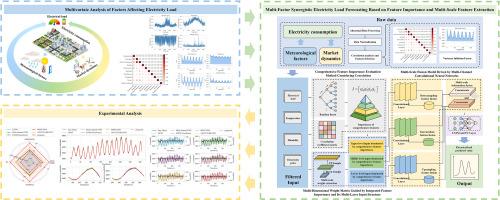基于特征重要度和多尺度特征提取的多因素协同电力负荷预测方法
IF 9.6
Q1 COMPUTER SCIENCE, ARTIFICIAL INTELLIGENCE
引用次数: 0
摘要
在电力系统中,环境波动和电价波动带来了用户能源消费行为的不确定性,对可靠的能源规划提出了重大挑战。现有研究往往忽视了多个复杂变量的重要性和相关性之间的耦合关系,缺乏对多维特征在多尺度空间中的权重和分布的考虑,在复杂时空特征的多尺度提取和融合方面存在不足。针对这些问题,本文提出了一种基于特征重要度和多尺度特征提取的多因素协同负荷预测方法。首先,建立了一种新的特征重要性与相关性相结合的评价模型,提出了一种特征重要性综合评价方法。然后,设计了多维权值提取框架,构建了多维权值矩阵及其多层输入结构;最后,建立了一个多通道卷积神经网络驱动的多尺度融合模型。骨干网是一个多通道卷积结构,前端是多级特征提取模块,中间是多尺度采样机制,后端是多尺度特征融合架构。基于所提出的综合特征重要性评价方法,建立了多因素协同负荷预测模型,实现了准确的负荷预测。实验结果表明,与各种最先进的预测模型相比,该方法将平均绝对误差(MAE)、均方根误差(RMSE)和平均绝对百分比误差(MAPE)分别降低了28.30%、24.14%和30.35%。本文章由计算机程序翻译,如有差异,请以英文原文为准。

A multi-factor collaborative electricity load forecasting method based on feature importance and multi-scale feature extraction
In power systems, environmental fluctuations and electricity price volatility introduce uncertainties in user energy consumption behaviors, posing significant challenges to reliable energy planning. Existing studies often overlook the coupled relationships between the importance and correlations of multiple complex variables, lack consideration of the weighting and distribution of multi-dimensional features across multi-scale spaces, and fall short in multi-scale extraction and fusion of complex spatiotemporal characteristics. To address these issues, this paper proposes a multi-factor collaborative load forecasting method based on feature importance and multi-scale feature extraction. First, a novel evaluation model integrating feature importance and correlation is developed, and a comprehensive feature importance assessment method is proposed. Then, a multi-dimensional weighting extraction framework is designed, from which a multi-dimensional weight matrix and its multi-layer input structure are constructed. Finally, a multi-scale fusion model driven by a multi-channel convolutional neural network is developed. The backbone network is a multi-channel convolutional structure, consisting of a multi-level feature extraction module in the front, a multi-scale sampling mechanism in the middle, and a multi-scale feature fusion architecture in the rear. Based on the proposed comprehensive feature importance assessment method, a multi-factor collaborative load forecasting model is established, achieving accurate load prediction. Experimental results demonstrate that, compared with various state-of-the-art forecasting models, the proposed method reduces Mean Absolute Error (MAE), Root Mean Square Error (RMSE), and Mean Absolute Percentage Error (MAPE) by up to 28.30 %, 24.14 %, and 30.35 %, respectively.
求助全文
通过发布文献求助,成功后即可免费获取论文全文。
去求助
来源期刊

Energy and AI
Engineering-Engineering (miscellaneous)
CiteScore
16.50
自引率
0.00%
发文量
64
审稿时长
56 days
 求助内容:
求助内容: 应助结果提醒方式:
应助结果提醒方式:


